Forest & Shade Tree – Insect & Disease Conditions for Maine
October 29, 2021
In This Issue:
This is our last planned bulletin of the season; there will be other pieces shared with our electronic subscribers as issues arise, and if especially significant, with our paper subscribers as well. We wish our readers well in the coming winter months. Please take some time this fall and winter to get out and enjoy Maine’s forests, and let us know if you see tree damage of concern. Show a friend some of the wonders (and scourges) of the natural world, help them engage in our forest health monitoring network.
With best wishes for your health (and that of the forests) and happiness now and in the future,
Aaron, Abby, Allison, Amy, Colleen, Jeff, Joe, Mike, Tom and Wayne
Browntail Moth (Euproctis chrysorrhoea)
This year we saw continued growth in the outbreak of browntail moth (BTM). Call activity was very high, with well over 500 BTM calls and a similar amount of emails received by the Maine Forest Service (MFS) from mid-May to August. This was in addition to calls fielded by 211 (287 calls) and other agencies such as Maine Center for Disease Control (CDC), Maine Board of Pesticide Control (BPC) and Cooperative Extension. As we did last year, we provided regular BTM developmental updates to the public and our cooperators to keep everyone up to date.
When warranted, we fly two rounds of aerial survey for BTM each year: one in late spring/early summer to pick up defoliation from the mature caterpillars and another in late summer/early fall to capture the skeletonization damage from the newly hatched caterpillars. The spring survey revealed 172,870.5 acres of defoliation while the fall surveys produced an additional 26,849.5 acres. This brings the grand total for 2021 to 199,720 acres. There was some overlap in areas mapped between the two surveys, so the total of unique acres mapped is 198,773, which is again a marked increase from 2020 where the total aerial defoliation was 153,680 acres. In 2021, damage was mapped in Oxford and Hancock Counties for the first time in this outbreak (prior to this, winter webs had been observed and reported on in these counties).
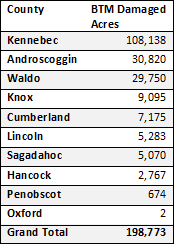 |
The annual winter web survey wrapped up in late March. This year MFS moved away from the “risk map” format in favor of a new way to share the information related to our monitoring surveys. This is, in part, due to the broad extent of detections. The new format displays the raw winter web survey data points along with the aerial defoliation and damage polygons. In the winter of 2021, field staff detected webs in Aroostook County (Fort Fairfield, Monticello and Smyrna) for the first time since the early 1900’s outbreak. This speaks to the ability of this species to hitch-hike rides on vehicles as the caterpillars, pupae and adults will all take a free ride when they get the chance.
By the second week of April, BTM caterpillars had emerged from their winter webs in Southern Maine to feed on the buds and newly emerging leaves of host trees. By the second week of May, many of the monitoring sites had fourth instar caterpillars, which are distinguished by their white tufts on each body segment. This was 2 weeks earlier than in previous years. One explanation for this is that the mild, early spring may have coaxed the caterpillars to emerge and therefore begin feeding earlier. There was quite a bit of variability in size even within a single nest with some caterpillars being as large as 17 mm while others that were 7 mm looked as if they had not molted since they emerged in April. During the second week of May, we began receiving reports of wandering caterpillars, which usually doesn’t occur until the end of May. This might be explained by caterpillars stripping the host plants they emerged on and their need to find better quality food. During the second week of June MFS staff made observations of the first caterpillars pupating at all our monitoring sites. Again, this was a couple of weeks earlier than has been seen in the past (June 26 in 2020). Beginning the week of June 27th, we began observing emergence of the adult BTM. During the period of adult activity, we received many photos as well as witnessed firsthand the sheer number of adult moths that were attracted to gas station lights as well as any other bright outdoor light. In many areas it looked as is if it had snowed around the lights. We began seeing the first egg masses hatch during the week of August 1, and by the third week of August we observed caterpillars starting to create the web in which they will spend the winter. In late August, we began observing feeding damage from young BTM caterpillars becoming very apparent in many areas, especially in Kennebec County.
As a silver lining to the season, in spite of another year of drought, we observed a few very small and isolated pockets of a BTM-pathogenic fungus and what looks to be the baculovirus associated with BTM in Belfast, Liberty, Jefferson, Blue Hill, Readfield and Dresden; they are likely found in many places in between. What this tells us is that the fungus and virus are very widespread, but in order for these pathogens to spread more and make a significant impact on populations we really need wet weather in May and June. In collecting some of the diseased caterpillars at our monitoring sites for use in future assisted disease dispersal work, we found both parasitoid wasp larvae as well as some fly puparia within the collecting containers. Using the collections of infected caterpillars, we performed some assisted disease dispersal inoculations in Old Town as well as Little Deer Isle since these locations are on the approximate leading edge and these BTM populations did not show signs of epizootic infections.
One observation of note in September was a few webs that have deceased browntail moth caterpillars on the outside of the web. It seems to us that this may be due to a pathogen, although we can’t say for sure. Symptomatic caterpillars were fairly widespread on the State office complex in Augusta with most trees that were inspected having at least some webs with deceased caterpillars on them. During this visual inspection we also noticed some flies in the family Tachinidae investigating the webs. The larvae of this family of flies are exclusively parasitic on arthropods of all shapes and sizes. There are a few species of tachinid fly that use browntail caterpillars as a host- good news for us and the flies.
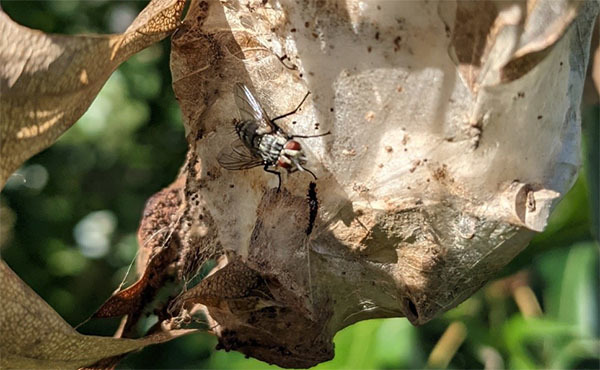 Image: Tachinid fly on browntail moth winter web. Augusta, Maine.
In cooperation with other State Agencies like Maine CDC, Maine BPC and the State Veterinarian, we have completed a major revision to the BTM frequently asked questions page that should be live online within the next week. Additions include updated pesticide information, questions on injection treatments and human/ animal health questions.
Emerald Ash Borer (Agrilus planipennis)
In October many of the ash trees girdled in the spring were peeled and inspected for signs of emerald ash borer (EAB). Over 50 trees were girdled in the spring by the Maine Forest Service and cooperators. This year we had wonderful participation by private landowners, which helped us monitor for EAB more widely throughout the state. Well over half of the trees have been peeled, and we have found EAB in two of them. In Frenchville (Aroostook County), we found EAB in a girdled tree at a site we hope to use for future biological control. This is the second time we have found EAB in Frenchville. In Cumberland County, we found EAB for the first time in the town of Falmouth, also at a potential biological control release site.
The remaining girdled trap trees will be processed over the coming weeks. If you have a girdled tree on your property and have not yet made arrangements with us for peeling, please contact us at foresthealth@maine.gov. We have one more workshop planned in Old Town on November 3. We will also continue to collect and peel trees at other sites throughout the state as needed. If you need assistance felling or transporting your tree, please let us know.
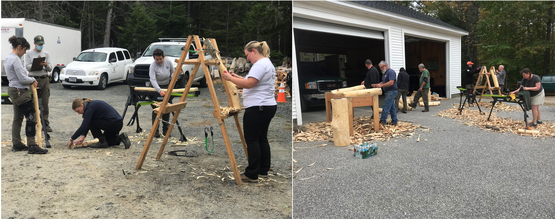 Image: Maine Forest Service staff and cooperators peel ash at Acadia National Park (left) and Gray Ranger Station (right).
In other EAB monitoring news, another season of monitoring for EAB with purple prism traps is in the books, with no new detections in 2021 using this method. These traps are used as a means of detecting new infestations in currently non-regulated areas and 171 traps were places in ash trees across the state at high-risk locations. We thank those private landowners, especially campground owners, who continue to let us hang these traps on their properties and understand that the firewood passing through their gates all summer can potentially have real consequences for forest pest spread. Overall, we collected nine beetles in the same genus as emerald ash borer (Agrilus) in 2021. In addition to external anatomy, dissection of these samples under the microscope back in the lab allowed us to use internal anatomy to confirm that these were all native Agrilids. We’ll be back at it again in 2022 and hope to monitor 200 sites as we have in previous seasons. We hope you will consider joining us in monitoring for EAB, through visual surveys, establishment of trap trees, or monitoring of Cerceris wasp sites.
The release of EAB natural enemies has concluded for 2021. Throughout the summer we released three species of tiny EAB parasitoids at seven sites in southern Maine. Tetrastichus planipennisi and Spathius galinae parasitize larvae under the bark, and the tiny Oobius agrili is a parasitoid of eggs on the bark surface. We will continue to release these parasitoids at the seven sites for one more season before we start to monitor for their establishment. Our neighbors in New Hampshire have been releasing these parasitoids for several years and have recovered at least one species at almost all their release sites, so we have high hopes for these tiny natural enemies of EAB. Although they will not protect mature trees now standing, there is some promising evidence that they can protect the next generation of young ash.
The same three parasitoids were released in northern Maine in 2019, and this year we conducted a trapping program to monitor for their establishment. We will be processing the samples this winter to determine whether any were recovered.
Hemlock Woolly Adelgid (Adelges tsugae)
In October and November, the winter generation of hemlock woolly adelgid (HWA) is starting to grow their wool and increase in size. Winter is a good time to inspect your trees for this destructive pest. As you walk through your hemlocks, flip over branches and look for ‘fuzzy’ white specks at the bases of needles on the new growth. Don’t forget to look at branches that have fallen to the ground or at trees that have recently been felled, as this will give you information about what is happening high in the canopy.
Early winter is also a good time to do major work in your hemlock stands and trees as you do not need to worry about spreading HWA or about infesting your healthy trees at this time of year. In most years you can expect hemlock to be free from eggs and mobile crawlers through February in Maine. In addition, doing heavy work in your hemlock stand in the winter when the ground is frozen, will help protect the sensitive roots of hemlock from damage.
This autumn, we continued releasing the HWA predator, Laricobius osakensis, a small beetle. We established a new release site in the Waldoboro town forest, and hope to release additional beetles at the site established last year in Vaughan Woods State Park.
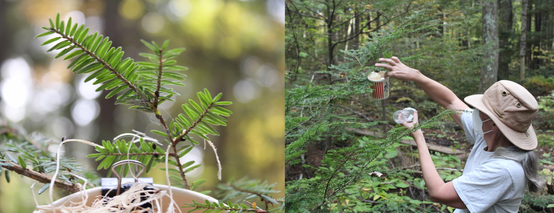 Image: (left) Predatory beetles move onto foliage and begin to feed; (right) Releasing HWA predators. Photo credits: Leslie Lorentzen.
Jack Pine Plantation in Decline
Earlier this season, a forest ranger pilot flew over a sorry looking stand of conifers near Baker Lake in northern Somerset County. He snapped a few rather alarming pictures of bright red trees and sent along the approximate coordinates for our follow-up. It appeared to be a mixed stand of spruce-fir and seeing how the fir looked great, we immediately ruled out spruce budworm defoliation and shifted our concerns towards a possible spruce beetle outbreak pocket. Much to our surprise, when we contacted the forester managing this area, we learned there is little spruce here and that this is in fact an old, experimental jack pine plantation deep in the heart of the North Maine Woods (T8 R17 WELS). Since we only had approximate coordinates and multiple people had visited the site without finding much evidence from the ground, we once again reached out to a forest ranger in the area for some assistance in finding the right area using a drone. Sure enough, the drone photos appeared almost as dramatic as the summer photos, though the true extent of the discoloration remained difficult to detect even while standing directly beneath the damaged trees.
A great deal of needle drop has already occurred in this stand and many of the remaining canopies are nothing more than small tufts at the very tops of these large trees, meaning it’s likely they’ll continue to decline. This isn’t surprising given the age of this stand and lack of management since it was abandoned, but the question still remains of what caused such an abrupt decline in the health of these trees. The climate in this part of Maine is certainly not too harsh for the resilient Jack pine and they are certainly able to withstand the drought that plagued the area in 2021.
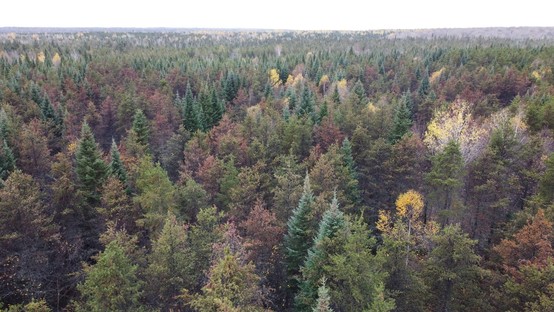 Image: Drone-captured aerial image of the discolored and declining jack pine plantation near Baker Lake.
The most compelling evidence was found on some trees that had fallen over. It appears this plantation has suffered a great deal of damage from an obscure species known as northern pitch twig moth (Petrova albicapitana). The moth larvae feed for multiple years beneath the bark where finer branches join main branches, resulting in an obvious gall-like growth around the feeding area formed mostly from frass and resin. The damage within this protected feeding area results in partially or fully girdled branches, which could explain the abundance of dead needles that were visible during the summer and that now litter the ground at this site. Because the life cycle takes multiple years and is not synchronized, there is continual pest pressure from this moth each season. In an even-aged plantation where many over-mature trees might be decreasing in vigor simultaneously, conditions may have been right to allow this normally insignificant insect to achieve significant pest status.
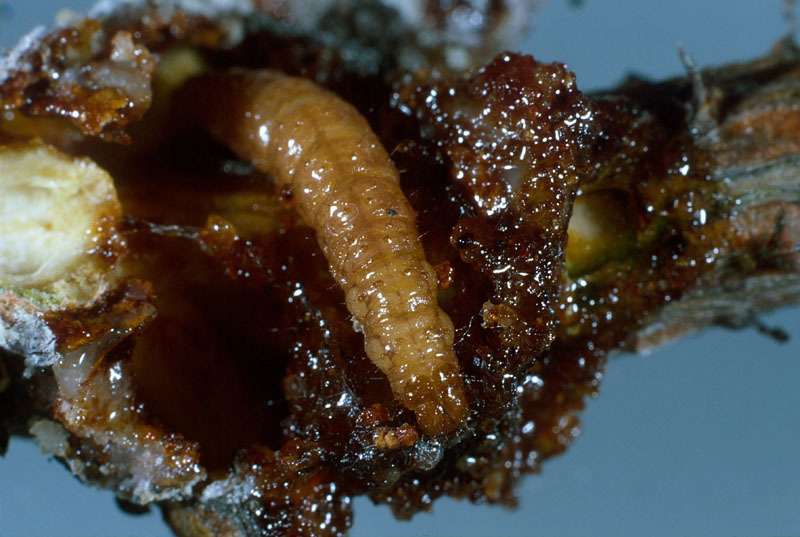 Images: Example of a larva of and nodule formed by Northern pitch twig moth. (Natural Resources Canada)
Out-of-State Firewood Concerns
October was a busy month in terms of out-of-state firewood inspections, with two situations of high concern brought to our attention. The first involved the voluntary surrender of a load of firewood brought to Maine from Vermont by a visitor unaware of the out-of-state firewood ban. The wood was collected by a forest ranger and transferred over to the Insect and Disease lab for inspection. We credit this positive outcome to additional new signage on the border emphasizing that all out-of-state firewood is banned from entering Maine. The only exception to this rule is firewood that has been certified heat-treated, in which case it must be accompanied by documentation indicating it has been heat-treated to Maine’s required standard.
The second case involved a larger load of firewood from Pennsylvania brought to a camp property, which we was reported to Forest Protection. A ranger followed up, and recovered the firewood which was inspected in Old Town, then incinerated at the Charleston Correctional Facility.
The results of these inspections were fortunate, considering that both Vermont and Pennsylvania are unfortunately afflicted with multiple forest pests that travel in firewood and pose direct threats to Maine’s forests. Although we did not find any of the forest pests that we fear the most in these particular instances, we did find ample evidence of other insect and fungal activity in multiple tree species, including live beetle larvae in well-seasoned firewood. This demonstrates once again the obvious risks of long-distance firewood transport and the reason Maine and other states choose to ban firewood from high-risk out-of-state areas.
We thank our colleagues in the Forest Protection division for their outreach and enforcement activities related to Maine’s firewood ban and Charleston Correctional Facility for their assistance with incinerating the large batch of wood from Pennsylvania.
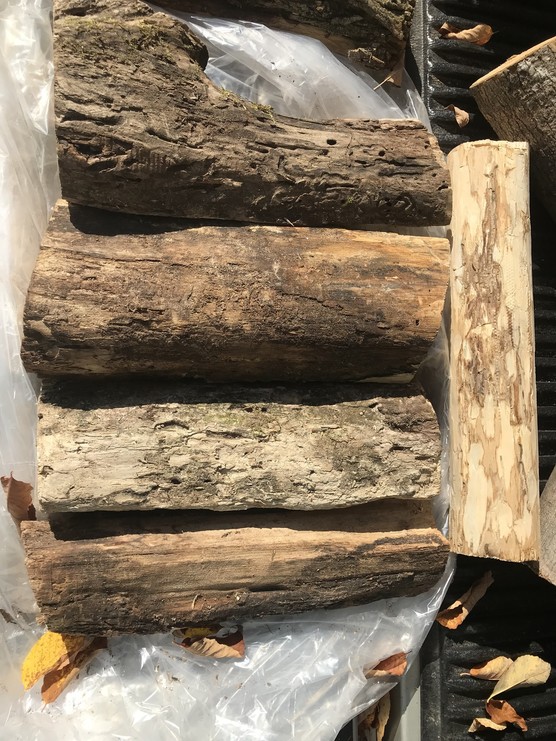 Image: Surrendered firewood from Vermont showing evidence of insect galleries on multiple tree species.
Spruce Budworm (Choristoneura fumiferana)
A few late October days spent in the North Maine Woods taking down spruce budworm (SBW) pheromone traps and collecting branch samples to quantify the number of second instar overwintering larvae (L2 survey) provided the perfect opportunity to reflect on the 2021 monitoring season. We began the season knowing that moth captures in 2020 were still somewhat elevated at an average 36 moths per trap statewide, though still not as high as the 2019 average of 67 moths per trap, bolstered then by mass migration events. This was not much of a surprise, as SBW larvae were not difficult to find in northern Maine during the 2020 growing season and defoliation was documented on the ground in several locations. The results of the 2020/2021 L2 survey painted much the same picture. The average number of larvae recovered per branch sample increased in many locations, with the most dramatic increases seen in the Cross Lake area. Here, one sampling site returned an average larval density of 7.66 per branch, reaching the threshold for treatment according to Early Intervention Strategy (EIS) protocols developed in neighboring Canada that many Maine landowners and managers seek to mirror. Additional L2 samples were taken in the areas surrounding the high sample near Cross Lake to define the boundaries of the highest population density, resulting in a treatment zone of several thousand acres that was successfully treated by the landowner using an aerial application of Btk. Visually, these treated stands experienced little defoliation damage when compared to untreated stands in nearby areas. Like 2020, defoliation damage from spruce budworm larvae remained apparent during ground surveys in many areas in 2021. Perhaps the greatest milestone indicating continued population increase was seen from above, with spruce budworm defoliation visible during aerial survey for the first time in decades. In a season plagued by a variety of forest health issues, especially drought, our follow-up ground-truthing surveys confirmed that spruce budworm feeding was indeed the cause of mapped discoloration. The damage observed during aerial survey amounted to almost 850 acres, although it’s certainly possible there is more damage in remote areas not covered during the 2021 aerial survey. Knowing this damage exists, we expect the results of the L2 survey to uncover additional locations that could be candidates for EIS-driven treatments in 2022.
As we head into the tail end of the monitoring season, pheromone trap samples are arriving at the lab steadily and still await counting. A quick glance in the traps shows that counts at MFS sites in western and central Maine appear to be quite low again this year, but we have yet to see samples from our sites further north where SBW populations are known to be higher. Branch samples for the 2021/2022 overwintering L2 larvae survey are now being submitted to a brand-new processing lab right here in Maine at the University of Maine – Orono, established through support of the Cooperative Forestry Research Unit and under direction of University of Maine Forest Entomologist Angela Mech. We were fortunate enough to receive a quick tour from Dr. Mech and lab manager James Stewart while dropping off some of our MFS branch samples, and we’re very grateful to have this asset in-state. As always, the complete results of the annual SBW monitoring program will be reported on in early spring of 2022 once all the counting work is finally behind us and all data are available.
Winter Moth (Operophtera brumata)
Reports of winter moth defoliation came in from the Boothbay Harbor region Kittery, a few of the islands off the coast of Portland including Cushing, Peaks, the Diamonds and Chebeague Island as well as Bristol and Mount Desert.
Winter moth is another invasive defoliator, and unlike browntail moth, it has an introduced biological control with an excellent track record of bringing populations within reach of other established natural controls, so that the moth can be brought down to endemic levels. There has been a lapse in funding for winter moth biocontrol efforts in recent years due to success in management of winter moth in Southern New England. We are hopeful that a funding proposal recently submitted by our cooperators in Massachusetts and supported by Maine Forest Service and land trusts, and federal land managers in Maine will be accepted so that more resources can be put towards collection of parasitized caterpillars and introduction of the biological control agent along the leading edge of winter moth populations in Maine.
The annual release of Cyzenis albicans flies, the biocontrol agent for winter moth, took place on May 17 in East Boothbay Harbor. This year’s host homeowners, who allowed the cage of fly puparia to be buried on their property for overwintering, lovingly cared for the flies as they emerged and even fashioned a homemade sign to deter curious hands. Each fly is precious, as only 150 were available for release in 2020, and they have a lot of catching up to do!
Image: Sign on Cyzenis albicans release cage.
On May 25, MFS staff collected winter moth caterpillars to further our biocontrol program. Caterpillars were collected at some of our previous release sites including Fort McClary State Park, Two Lights State Park, Harpswell, South Portland, and Bath. A portion of these caterpillars are infected with the parasitoid fly Cyzenis albicans (the proportion of parasitism varies by location), which is the most effective and specific biocontrol for winter moth. Caterpillars were harder to come by, as has been the case for the past couple of years. The caterpillars we collected were sent to our collaborators at the Elkinton Lab at the University of Massachusetts at Amherst to determine the percentage of parasitism and prepare the parasitoids for overwintering.
From the June 2021 larval collections, the parasitism rates at the previous release sites were found to be 5.71% in Bath, 35.75% at Fort McClary State Park, 0.85% in Harpswell , 0.84% in South Portland and 10.95% at Two Lights State Park. The recoveries in Bath were the first at that site and were quite heartening because it was the first site where we had fewer than 1000 flies to release (only 500, released in 2019). The puparia for next year’s release will be delivered to Maine by cooperators from the Elkinton Lab Friday and tucked away for winter next week. We will have 329 C. albicans to overwinter for release next year in South Bristol, Maine.
Beech Leaf Disease: The Current Status of the Disease in Maine
Beech leaf disease (BLD) was first described in American beech trees in Ohio in 2012. Since then, discoveries of the disease have been confirmed in nine US states (CT, MA, ME, NJ, NY, OH, PA, RI, VA, WV) and Ontario Canada. In late May of this year, BLD was confirmed in Lincolnville, Waldo County. Before the find in Maine, the closest known location was in southeastern Massachusetts. The disease’s mode of spread is currently unknown. Following the find in Lincolnville, MFS surveys and reports from the public revealed that the disease was fairly widely spread throughout Knox and Waldo Counties, and just over the border into the western edge of Lincoln County. The MFS, in cooperation with the USFS Durham Field Office, established eight long-term monitoring plots in Maine to track the establishment and impacts of BLD. While setting up a plot in the Penobscot Experimental Forest, Penobscot County, BLD was detected. Thus, BLD had been confirmed in four Maine counties.
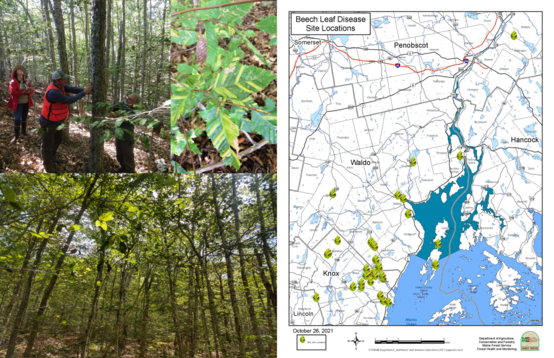 Image: (upper left) MFS Pathologist Aaron Bergdahl and Technicians Abby Karter and Wayne Searles evaluating beech tree health as part of establishing a network of USFS/MFS BLD long-term monitoring plots in Maine, image by Aleta McKeage, Waldo County Soil and Water District; (middle) Late-season BLD symptoms on American beech leaves showing yellow bands that were less conspicuous and darker in color earlier in the year. (lower left) The noticeable lack of leaf cover due to the impacts of BLD in the understory of a nearly pure beech stand in Waldo County; (right) The current distribution of beech leaf disease in Maine.
Drought
This growing season has been characterized by fluctuations in moisture availability for trees. May and June saw very dry conditions throughout the entire state, with extreme drought in some areas. This was followed by record precipitation in July. Despite this wet period, there are still parts of Maine in severe drought and abnormally dry conditions. Further, just because the precipitation totals have evened out for the growing season on average does not mean the stress experienced by trees during acutely dry conditions never happened or is erased. We will see the impacts of the dry May and June of 2021 in years to come. A tool available from the Forest Ecosystem Monitoring Cooperative (FEMC) housed at the University of Vermont, FEMC: Tracking Shifts in Disturbance Regimes - Drought, shows trends and highlights of recent drought disturbance in the region by compiling and analyzing data from multiple sources. The FEMC also has a variety of other interesting tools to explore at FEMC: Tracking Shifts in Disturbance Regimes.
 Image: U.S. Drought Monitor map of Maine
Seasonal Leaf Drop
The insect and disease lab has received several calls in recent weeks about pines dropping rust-colored needles in large quantities, covering lawns and driveways and accumulating in piles along roads. Some have expressed concerns about disease and have feared the worst for their beloved conifers. Thankfully, in all cases this phenomenon has been due to a natural process referred to as seasonal needle drop, although this year the process seems to be a bit more intense than in typical past years. This is not to be confused with needle drop of eastern white pine in the months of June and July associated with the white pine needle damage disease complex. White pine needle disease results in similar symptoms and is much more harmful to trees than seasonal needle drop.
In the autumn, all conifers drop needles as part of their preparation for the dormant season. The deciduous conifers, like the larches, dawn redwood and baldcypress, drop all their needles in the fall and regrow a fresh and full complement of foliage in spring. The non-deciduous conifers, which includes all of Maine’s native conifers except eastern larch/tamarack, drop only their older needles (leaves/leaflets in the case of cedars and junipers) in fall. There are several hypotheses explaining why trees do this related to energy- and water-saving strategies. The oldest needles on a tree are usually exposed to less sunlight, are less efficient at producing energy and are therefore less productive than newer needles. Also, due to their longevity, the oldest needles have been exposed to more insect/disease pressure and other damage, requiring more resources for maintenance and defense. Additionally, the more needles there are on a tree, the greater is the potential for water loss due to evapotranspiration, which can lead to winter burn symptoms in spring when the weather warms and much of the water in the soil may be frozen and unavailable for absorption into tree roots to replace water lost via evapotranspiration. Winter burn is especially a risk to conifers in landscape settings with full sun exposure. It can be mitigated by ensuring ornamental conifers are well-watered in the fall if rainfall is insufficient.
 Images: (top left, left) Eastern white pine tree before seasonal needle drop; (top left, right) The same eastern white pine tree after seasonal needle drop; (bottom left) A heavy carpet of fallen needles under the same tree after seasonal leaf drop; (right) An eastern white pine branch showing the orange second-year needles just before seasonal needle drop.
Tar Spot
There are several species of fungi in the genus Rhytisma that produce a tar spot symptom on our several types of trees and shrubs in Maine. Tar spot on Norway maple is caused by a non-native fungus (R. acerinum), and it is especially prevalent in several parts of Maine this year, as in most years. The also non-native (and currently considered invasive) Norway maples, including cultivars of Norway maple in horticultural settings, such as the burgundy-leaved Crimson King maple, are particularly susceptible to tar spot. Tar spots on our native maples are caused by native Rhytisma. They are encountered less frequently and typically cause only minor damage.
The fungi that cause tar spot survive the winter in fallen leaves and produce and disseminate spores during prolonged periods of wet weather in spring. Thus, collecting and disposing leaves is the recommended management strategy. If composting the collected leaves on-site, the leaf piles should be covered with a layer of soil, a dense layer of grass clippings or other compost. This will prevent the fungus from dispersing spores to re-infect maples the following spring. Leaves can also be burned when and where this is permitted. Chemical management of tar spot is rarely required or practical since these diseases primarily represent an aesthetic issue and have little detrimental effect on the long-term health of affected trees and shrubs.
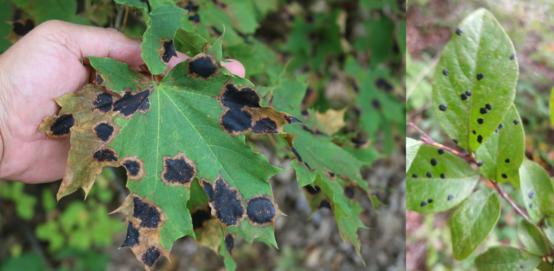 Images: (left) The conspicuous black spore-producing fungal spots of the tar spot of maple disease on Norway maple. Leaves with multiple infections eventually turn brown, and may have already dropped prematurely from the tree; (right) A related tar spot fungus on high bush blueberry, Rhytisma vaccinii, has been noticed in several parts of Maine this autumn.
From the October 1, 1991 Condition Report:
“Boxelder canker (cause unknown): In a recent newsletter we described the recurrence this year of an unknown but conspicuous canker disease of boxelder. While we had noted this disease in past years, we had never found it to be widespread. This disease is apparently unreported in the literature and our first attempts at diagnosis were hindered because we could find no causal organism fruiting in association with the cankers.
Since that early report, however, we have been able to isolate and repeatedly associate two different types of fungi with cankers on this host. One is a species of Fusarium, (possibly F. lateritium or F. roseum) and the other is a species of Coryneum (possibly C. negundis). It seems likely that the hard spring frost Maine experienced on May 19 predisposed the boxelder to infection. Probably the causal fungi present the potential for infection every year, but it takes a stress ‘trigger’ such as frost injury to initiate a substantial disease outbreak.”
November 3. Log Peeling Workshop. The MFS will be peeling ash logs in Old Town to monitor for emerald ash borer. If you have a girdled tree on your property and have not yet made arrangements with us for peeling, please contact us at foresthealth@maine.gov for more details.
November 3–4, Registration Open! White Pine Weevil, Management and Tree Improvement. The Atlantic Tree Improvement Council (AtlanTIC) in conjunction with the Canadian Woodlands Forum and the Canadian Wood Fibre Centre will be hosting a virtual workshop on white pine weevil management and tree improvement. The white pine weevil is a major pest of white pine, Sitka spruce, white spruce, jack pine, Norway spruce and other species in Canada. This event will bring together white pine weevil experts, tree improvement specialists, forest managers and others to share knowledge associated with white pine weevil management in our forests and for the purpose of accelerating the implementation of plans to develop trees resistant to weevils.
Conditions Report No. 7, 2021
On-line
Department of Agriculture Conservation & Forestry Maine Forest Service – Forest Health and Monitoring
Contributors: Aaron Bergdahl, Amy Emery, Allison Kanoti, Mike Parisio, Colleen Teerling, and Thomas Schmeelk
Unless otherwise noted, images by Maine Forest Service, Forest Health and Monitoring, DACF
|